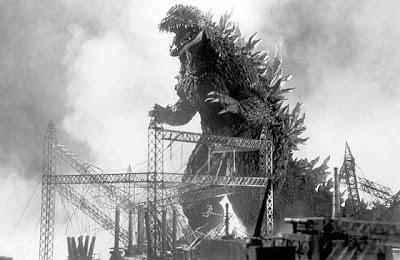
If the Busoni concerto were a Japanese movie monster, this is who it would be.
Image of Godzilla (Gojira) © 1954 Toho Studios. Character of Godzilla is the property of Toho Studios.
Among German composers of the early 20th century, Busoni (a German, despite the Italian name) is looked at as something of an evolutionary dead end, with few followers of his footsteps or much interest in his difficult ideas of a new musical language. With this concert, Mr. Lacombe sought to disprove that thesis: programming the Concerto with works by his students Kurt Weill and Edgar Varèse, composers who took very different musical paths.
The blue kerchief-waving supporters of the NJSO seemed disconcerted by the Varèse work, the final entry in this groundbreaking composer's small catalog. Nocturnal is an uncompromising slab of sound: a harrowing nine minutes of block tone-clusters, spurts of percussion and wordless utterance from the Men of the Westminister Symphonic Choir. Soprano Hila Plitmann sang and declaimed the text of Nocturnal with a tone that veered between seduction, religious ecstasy and screech.
Kurt Weill is remembered for his operas and songs, and this terse, one-movement symphony (a product of his student years) may show why. This piece finds the composer somewhere between Mahler and Webern, with terse musical phrases and slanting rhythms. The work is one movement, groaning with an abundance of thematic development that seems to tumble over itself in its hurry to be stated. Lost for many decades, this performance marked this work's Carnegie Hall premiere.
There are a number of reasons why Busoni's lone concerto is rarely performed. It's a five-movement marathon. At 70 minutes in length, it is comparable to Beethoven's Ninth Symphony. Like that more famous work, Busoni brought in a chorus in the final movement, to sing a setting of Aladdin by the Danish poet Adam Oehlenschläger. However, the biggest obstcle to regular performances is the solo piano part, which is fearsomely difficult to play but lacks the flash of virtuosity that is so popular with concert pianists.
Happily, Marc-André Hamelin is an artist who remains more interested in making music than showing off his chops. He entered into the first movement with a liquid, singing tone, bringing a clarity to these complex, often contrapuntal piano lines that sounded deceptively easy. For much of this movement, he stayed "in the pocket", enveloped by the vast orchestral palette. Something was lacking in the long exposition of the first movement, and the concerto's complex narrative (based to some degree on principles of Italian architecture) took some time to take shape.
The two dance movements (the second is marked Scherzo and the fourth, Tarantella) were played with rhythmic ferocity and grace, as the soloist's hands flew over the keys. The central slow movement, with its four carefully argued sections could have been a concerto in itself. Mr. Hamelin conveyed the nobility of the writing without losing sight of the narrative.
The problem with the performance (and it was a minor one) was balance, with the brass at stage left occasionally over-enthusiastic. However, Mr. Lacombe found the right proportion between soloist, orchestra and chorus in the powerful, surging finale, which sounded neither pompous nor self-indulgent. Mr. Hamelin ended the concert with more Busoni: the Elegy No. 4 from the composer's opera Turandot (not to be confused with Puccini's work.) The audience laughed with delight when they recognized the tune, a series of jaw-dropping variations on the English song Greensleeves.

